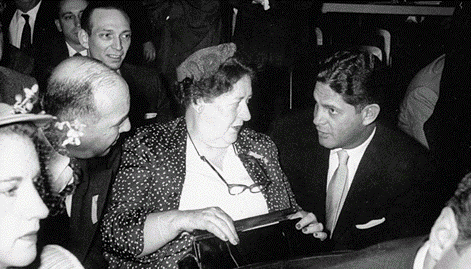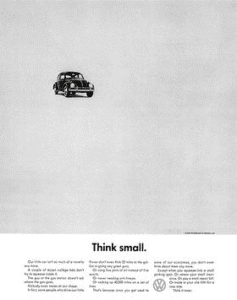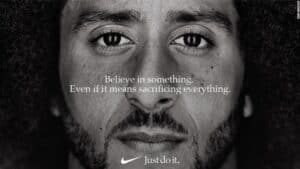It might surprise you to learn that the apparently unassuming and conservative lady from a bygone era at the heart of this photograph, was actually a trailblazing figure in the world of advertising -noted for her innovative and creative approaches in a field that was, at the time, heavily dominated by men.
Born in 1894, Bernice Fitz-Gibbon’s career spanned several decades, most notably during the mid-20th century.
Her most significant contributions were in retail advertising. Remembered specifically for her work with department stores (particularly Macy’s and Gimbels), Fitz-Gibbon’s style was characterised by wit, humour, and an understanding of consumer psychology.
And she is also known for this quote:
“A good ad should be like a good sermon: It must not only comfort the afflicted, it also must afflict the comfortable.”
She was right, of course.
Understanding this was one of the reasons she was so good.
She knew that a good ad must speak to the customer about what’s important to them: deliver to the things that they care about; strike a note of familiarity; offer solutions to their problems; give them what they expect.
But she also knew that a really good ad does way more than that.
It shakes people awake.
It pokes them where they didn’t expect to be poked.
Makes them think twice.
Makes them think again.
Makes them change their behaviour.
It’s something that all of us in the marketing profession would do well to remember.
Really good marketing zags when others are zigging.
Ads that dared to be different
In your lifetime you’ll have seen (or heard) hundreds of thousands of ads. I can’t prove it, but it’s true. When we’re exposed to upwards of 5,000 brand messages a day it’s not hard to arrive at a figure that’s so high.
It could be higher.
But how many of them do you actually remember?
You see, that’s the test.
Does an ad have enough impact on you, that years down the line, you still remember the brand?
If you want your advertising to be effective, it needs to cut through a lot of noise. You’ve got to do something that stops people from doing the thing they were doing, and pay attention to what you have to say.
You’ve got to shake things up a bit.
Here are just a few examples of ads that did something different.
Dove: Real Beauty
Dove’s “Real Beauty” campaign, launched in 2004, was groundbreaking advertising because when most industry ads focused on unattainable standards of beauty, Dove’s campaign boldly challenged the accepted norms. By showcasing real women with diverse body types, ages, and ethnicities, Dove appealed to consumers who felt excluded or misrepresented by traditional beauty ads.
Budweiser: Whassup?
A campaign that originally aired in 1999, this ad had viral potential before ‘viral’ was even a thing. “Whassup” became a part of the vernacular at least for a time – essentially another ad for Budweiser every time the phrase was repeated. Not just a cultural hit, it drove significant sales, and won numerous industry awards including a Cannes Grand Prix.
Volkswagen: Think Small
A classic example of zagging against the zig. This VW campaign from 1959 is often hailed as a watershed moment in advertising history. In an era dominated by huge all-American cars and ads that boasted size, power and luxury, ‘Think Small’ celebrated the simplicity, small size and efficiency of the Beetle. And the humour and minimalist design of the ads really broke the mold.
Nike: Colin Kaepernick
In 2018 Nike took a stand, by backing Colin Kaepernick, an American Footballer who had taken the knee in protest during the US national anthem. For many brands, the line “Believe in something. Even if it means sacrificing everything” would have lacked authenticity – but Nike understood their audience; younger, diverse and more socially progressive and were willing to risk alienating their more conservative customers.
Of course, there are plenty more great examples of ads that have made us think differently, or at least stop and think. And every year, the advertising industry delivers some absolutely fantastic pieces of work.
Ads don’t have to say anything important. But they do need to be noticed.
But the reality is that most advertising is just wallpaper.
Wallpaper, because most advertising doesn’t say much, that’s very interesting. Most advertising lacks personality.
It’s vanilla. Hardly discernible from its competitors.
And that’s a shame because advertisers spend a lot of money on advertising space.
Most SMEs can’t afford to waste money.
You don’t need to be a corporate giant to act like one
If you’re an SME or even a large business with a limited marketing budget, you’re not precluded from delivering advertising that gets real cut through. You don’t have to spend a huge amount.
But you do have to be prepared to do some homework.
Understand your market thoroughly.
Know exactly where you out-gun the competition.
Establish a clear market positioning and stick with it.
Then be brave.
When we’re bombarded by average, vanilla ads, it’s the bold, the brave, and sometimes the bizarre that really cut through the noise.
Safe is comfortable, but it’s also forgettable.
Safe is camouflage.
Camouflage is the opposite of what you’re trying to do.
Tried and tested formulas never changed anything.
Great rewards come from taking risks.
Bernice Fitz-Gibbon stood out in a world dominated by men. In a world of mediocre advertising, your brand has a chance to really stand out.
Remember, afflict the comfortable and never, never be afraid to stand out.


